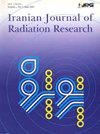Dosimetric comparison of single and double collimator stereotactic body radiotherapy plans using Cyber Knife for carcinoma prostate
Q4 Health Professions
引用次数: 0
Abstract
Purpose: This study was conducted to evaluate single collimator (SC) and double collimator (DC) plans with respect to dosimetric analysis, calculated dose delivery to OAR and treatment time in carcinoma prostate patients treated with cyberknife. Materials and Methods: A retrospective study was conducted among twenty low and intermediate risk carcinoma prostate previously treated with Cyberknife. PTV was created and OARs were delineated. The prescribed dose was set as 37.5 Gy in 5 fractions and a base plan (BP), followed by three reduction plans (time, beam and node) were generated for both single and double collimators with sequential optimization module. The SC and DC plans were compared for the above-said variables. The mean differences were compared using paired t-test. A p-value of <0.05 was taken as statistically significant. Results: The median age of the patients was 63 years. DC plans had tighter isodose lines. The means of minimum doses did not vary significantly across the plans but the mean and maximum doses, PTV D2 and V95 means were significantly higher in single collimator plan. The mean CI and HI values were better in DC plans. The doses to OAR were comparable in both single and double collimator plans in terms of maximum doses. The mean doses received by OAR’s were significantly lesser in DC plans.SC plans resulted in lesser beams, nodes, MU and treatment time. Conclusion: Double collimator plans were better in producing good dosimetric results and reduced OAR doses with lesser estimated treatment efficiency.射波刀治疗前列腺癌单、双准直器立体定向放疗方案的剂量学比较
目的:评价单准直器(SC)和双准直器(DC)方案在射波刀治疗前列腺癌患者的剂量学分析、OAR的计算剂量传递和治疗时间方面的效果。材料与方法:对20例既往行射波刀治疗的低、中危前列腺癌患者进行回顾性研究。建立了PTV,并划定了桨。将处方剂量设为37.5 Gy,分为5个分量和一个基本计划(BP),然后通过顺序优化模块对单准直器和双准直器分别生成时间、光束和节点3个缩减计划。比较SC和DC计划的上述变量。采用配对t检验比较均数差异。p值<0.05为差异有统计学意义。结果:患者中位年龄为63岁。直流电计有更紧的等剂量线。最小剂量平均值在不同准直器方案中差异不显著,但平均剂量和最大剂量、PTV D2和V95平均值均显著高于单一准直器方案。DC方案的平均CI和HI值较好。在最大剂量方面,单准直器和双准直器计划对OAR的剂量是相当的。在DC计划中,OAR接受的平均剂量明显较少。SC方案导致较少的束、节点、MU和治疗时间。结论:双准直仪方案可获得良好的剂量学结果,降低OAR剂量,但估计治疗效率较低。
本文章由计算机程序翻译,如有差异,请以英文原文为准。
求助全文
约1分钟内获得全文
求助全文
来源期刊

Iranian Journal of Radiation Research
RADIOLOGY, NUCLEAR MEDICINE & MEDICAL IMAGING-
CiteScore
0.67
自引率
0.00%
发文量
0
审稿时长
>12 weeks
期刊介绍:
Iranian Journal of Radiation Research (IJRR) publishes original scientific research and clinical investigations related to radiation oncology, radiation biology, and Medical and health physics. The clinical studies submitted for publication include experimental studies of combined modality treatment, especially chemoradiotherapy approaches, and relevant innovations in hyperthermia, brachytherapy, high LET irradiation, nuclear medicine, dosimetry, tumor imaging, radiation treatment planning, radiosensitizers, and radioprotectors. All manuscripts must pass stringent peer-review and only papers that are rated of high scientific quality are accepted.
 求助内容:
求助内容: 应助结果提醒方式:
应助结果提醒方式:


